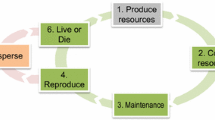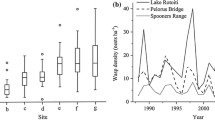Abstract
Intraspecific competition is a pervasive phenomenon with important ecological and evolutionary consequences in ants. However, its effect at population level remains less known. We investigated the effect of intraspecific competition on the demography of the leaf-cutting ant Acromyrmex lobicornis using a stochastic matrix demographic model parameterized with 3 years of census data. Given that competition is a negative interaction with potential consequences on fitness, we expected that nests that share their foraging area with conspecific nests would have a lower population growth rate than nests that did not. The stochastic growth rate of all sampled nests showed positive values, but with differences according to their competitive condition. Nests that did not share their foraging area showed a 34% annual growth, while nests that shared their foraging area with another conspecific nest showed only 13%. This difference appears to be related to a reduced probability that small nests grow to medium size in the competitive condition, this transition being the one that contributes the most to the population growth rate. These results suggest that competitive interactions often restrict the growth of small nest sizes, supporting previous evidence that proposed young ant colonies as the most vulnerable demographic stage. The known pattern of low overlap in ant foraging areas could be a consequence of a lower population growth rate of nests under competitive conditions. This illustrates how selective pressures on individuals (e.g., ant nests) can influence demography, emphasizing the role of intraspecific competition at population level and the potential consequences for species density and geographical ranges.





Similar content being viewed by others
References
Acosta F, Lopez F, Serrano JM (1995) Dispersed versus central-place foraging: intra-and intercolonial competition in the strategy of trunk trail arrangement of a harvester ant. Am Nat 145:389–411
Adams ES, Tschinkel WR (1995) Spatial dynamics of colony interactions in young populations of the fire ant Solenopsis invicta. Oecologia 102:156–163
Adler PB, Smull D, Beard K, Choi R, Furniss T, Kulmatiski A et al (2018) Competition and coexistence in plant communities: intraspecific competition is stronger than interspecific competition. Ecol Lett 21:1319–1329
Andersen AN, Patel AD (1994) Meat ants as dominant members of Australian ant communities: an experimental test of their influence on the foraging success and forager abundance of other species. Oecologia 98:15–24
Andersen AN, Blum MS, Jones TH (1991) Venom alkaloids in Monomorium “rothsteini” Forel repel other ants: is this the secret to success by Monomorium in Australian ant communities? Oecologia 88:157–160
Ballari S, Farji-Brener AG, Tadey M (2007) Waste management in the leaf-cutting ant Acromyrmex lobicornis: division of labor, aggressive behavior, and location of external refuse dumps. J Ins Behav 20:87–98
Benton TG, Grant A (1999) Elasticity analysis as an important tool in evolutionary and population ecology. Trends Ecol Evol 14:467–471
Bernstein RA, Gobbel M (1979) Partitioning of space in communities of ants. J Anim Ecol 48:931–942
Bollazzi M, Kronenbitter J, Roces F (2008) Soil temperature, digging behavior, and the adaptive value of nest depth in South American species of Acromyrmex leaf-cutting ants. Oecologia 158:165–175
Boulay R, Galarza JA, Chéron B, Hefetz A, Lenoir A, Oudenhove LV, Cerda X (2010) Intraspecific competition affects population size and resource allocation in an ant dispersing by colony fission. Ecology 91:3312–3321
Caswell H (2001) Matrix population models: construction, analysis and interpretation, 2nd edn. Sinauer Associates Inc., Publishers, Sunderland, p 722
Cerda X, Arnan X, Retana J (2013) Is competition a significant hallmark of ant (Hymenoptera: Formicidae) ecology? Myrmecol News 18:131–147
Chen W, O’Sullivan A, Adams ES (2018) Intraspecific aggression and the colony structure of the invasive ant Myrmica rubra. Ecol Entomol 43:263–272
Claessen D, Gilligan CA, Lutman PJ, Bosch FVD (2005) Which traits promote persistence of feral GM crops? Part 1: implications of environmental stochasticity. Oikos 110:20–29
Cushman JH, Martinsen GD, Mazeroll AI (1988) Density-and size-dependent spacing of ant nests: evidence for intraspecific competition. Oecologia 77:522–525
Del Vitto LA, Petenatti E, Nellar MM, Petenatti ME (1994) Las Áreas Naturales Protegidas de San Luis, Argentina. Multequina 3:141–156
Dimarco RD, Farji-Brener AG, Premoli AC (2010) Dear enemy phenomenon in the leaf-cutting ant Acromyrmex lobicornis: behavioral and genetic evidence. Behav Ecol 21:304–310
Eaton JW, Bateman D, Hauberg S, Wehbring R (2019) GNU Octave version 4.0. 0 manual: a high-level interactive language for numerical computations. 2015. http://www.gnu.org/software/octave/doc/interpreter(8, 13). Accessed 12 Sept 2015
Farji-Brener AG (2000) Leaf-cutting ant nests in temperate environments: mounds, mound damages and nest mortality rate in Acromyrmex lobicornis. Stud Neotrop Fauna Environm 35:131–138
Farji-Brener AG, Ruggiero A (1994) Leaf-cutting ants (Atta and Acromyrmex) inhabiting Argentina: patterns in species richness and geographical range sizes. J Biogeogr 21:391–399. https://doi.org/10.2307/2845757
Farji-Brener AG, de Torres Curth MI, Casanovas P, Naim PN (2003) Consecuencias demográficas del sitio de nidificación en la hormiga cortadora de hojas Acromyrmex lobicornis: un enfoque utilizando modelos matriciales. Ecol Austral 13:183–194
Fellers JH (1987) Interference and exploitation in a guild of woodland ants. Ecology 68:1466–1478
Fowler HG (1977) Some factors influencing colony spacing and survival in the grass-cutting ant Acromyrmex landolti fracticornis (Forel) (Formicidae: Attini) in Paraguay. Rev Biol Trop 25:89–99
Fowler HG (1992) Patterns of colonization and incipient nest survival in Acromyrmex niger and Acromyrmex balzani (Hymenoptera: Formicidae). Insect Soc 39:347–350
Fowler HG, Robinson S, Diehl J (1984) Effect of mature colony density on colonization and initial colony survivorship in Atta capiguara, a leaf-cutting ant. Biotropica 16:51–54
Fowler HG, Pereira-da-Silva V, Forti LC, Saes NB (1986) Population dynamics of leaf-cutting ants: A brief review. In: Lofgren CS, Vander Meer RK (eds) S and leaf-cutting ants: biology and management (studies in insect biology). Westview Press, Boulde, pp 123–145
Franzel C, Farji-Brener AG (2000) ¿Oportunistas o selectivas? Plasticidad en la dieta de la hormiga cortadora de hojas Acromyrmex lobicornis en el noroeste de la Patagonia. Ecol Austral 10:159–168
Gordon DM, Kulig AW (1996) Founding, foraging, and fighting: colony size and the spatial distribution of harvester ant nests. Ecology 77:2393–2409
Hernández JV, López H, Jaffe K (2002) Nestmate recognition signals of the leaf-cutting ant Atta laevigata. J Insect Physiol 48:287–295
Hölldobler B, Wilson EO (1990) The ants. Harvard University Press, Cambridge
Hölldobler B, Wilson EO (2011) The leafcutter ants: civilization by instinct. W. W. Norton and Company, Nueva York
Jofré LE, Medina AI, Farji-Brener AG, Moglia MM (2018) The effect of nest size and species identity on plant selection in Acromyrmex leaf-cutting ants. Sociobiology 65:456–462
Jofré LE, de Torres Curth MI, Farji-Brener AG (2022) Unexpected costs of extended phenotypes: nest features determine the effect of fires on leaf cutter ant’s demography. Proc R Soc B 289(1969):20212333
Keddy PA (1989) Competition. Chapman & Hall, London, p 202
Levings SC, Traniello JFA (1981) Territoriality, nest dispersion and community structure in ants. Psyche 88:265–320
Nobua Behrmann BE (2014) Interacciones tróficas entre dos especies simpátricas de hormigas cortadoras y el ensamble de plantas en el Monte central (Doctoral dissertation, Universidad de Buenos Aires. Facultad de Ciencias Exactas y Naturales)
Parr CL, Gibb H (2010) Competition and the role of dominant ants. In: Lach L, Parr CL, Abbott KL (eds) Ant ecology. Oxford University Press, Oxford, pp 77–96
Rockwood LL (1973) Distribution, density, and dispersion of two species of Atta (Hymenoptera: Formicidae) in Guanacaste province, Costa Rica. J Anim Ecol 803–817
Ryti R, Case T (1986) Overdispersion of ant colonies: a test of hypotheses. Oecologia 69:446–453
Savolainen R, Vepsäläinen K, Wuorenrinne H (1989) Ant assemblages in the taiga biome: testing the role of territorial wood ants. Oecologia 81:481–486
Solida L, Scalisi M, Fanfani A, Mori A, Grasso DA (2010) Interspecific space partitioning during the foraging activity of two syntopic species of Messor harvester ants. J Biol Res 13:3
Stubben CJ, Milligan B (2007) Estimating and analyzing demographic models using the popbio package in R. J. Statistical software 22, 11. https://CRAN.R-project.org/package=popbio. Accessed 12 Sept 2015
Tadey M, Farji-Brener AG (2007) Indirect effects of exotic grazers: livestock decreases the nutrient content of refuse dumps of leaf-cutting ants through vegetation impoverishment. J Appl Ecol 44(6):1209–1218
Tuljapurkar SD, Horvitz C, Pascarella JB (2003) The many growth rates and elasticities of populations in random environments. Am Nat 162:489–502
Vasconcelos HL, Cherrett JM (1995) Changes in leaf-cutting ant populations (Formicidae: Attini) after the clearing of mature forest in Brazilian Amazonia. Stud Neotrop Fauna Environ 30:107–113
Vieira-Neto EH, Vasconcelos H, Bruna EM (2016) Roads increase population growth rates of a native leaf-cutter ant in Neotropical savannahs. J Appl Ecol 53:983–992
Acknowledgements
We thank Kety Huberman for constructive criticism of an earlier version of the paper. Two anonymous reviewers and the editor made several constructive comments that helped to improve the first version of this manuscript.
Author information
Authors and Affiliations
Contributions
AGFB conceived the idea of the study, AGFB. and LJ designed methodology; LJ collected the data; LJ, MDTC and VZ analyzed the data; AGFB led the writing of the manuscript. All authors contributed critically to the drafts and gave final approval for publication.
Corresponding author
Ethics declarations
Conflict of interest
Not applicable.
Rights and permissions
About this article
Cite this article
Jofre, L., de Torres Curth, M., Zimmerman, V. et al. Effect of intraspecific competition on the demography of leaf-cutting ants: a matrix model approach. Insect. Soc. 69, 261–269 (2022). https://doi.org/10.1007/s00040-022-00866-4
Received:
Revised:
Accepted:
Published:
Issue Date:
DOI: https://doi.org/10.1007/s00040-022-00866-4




